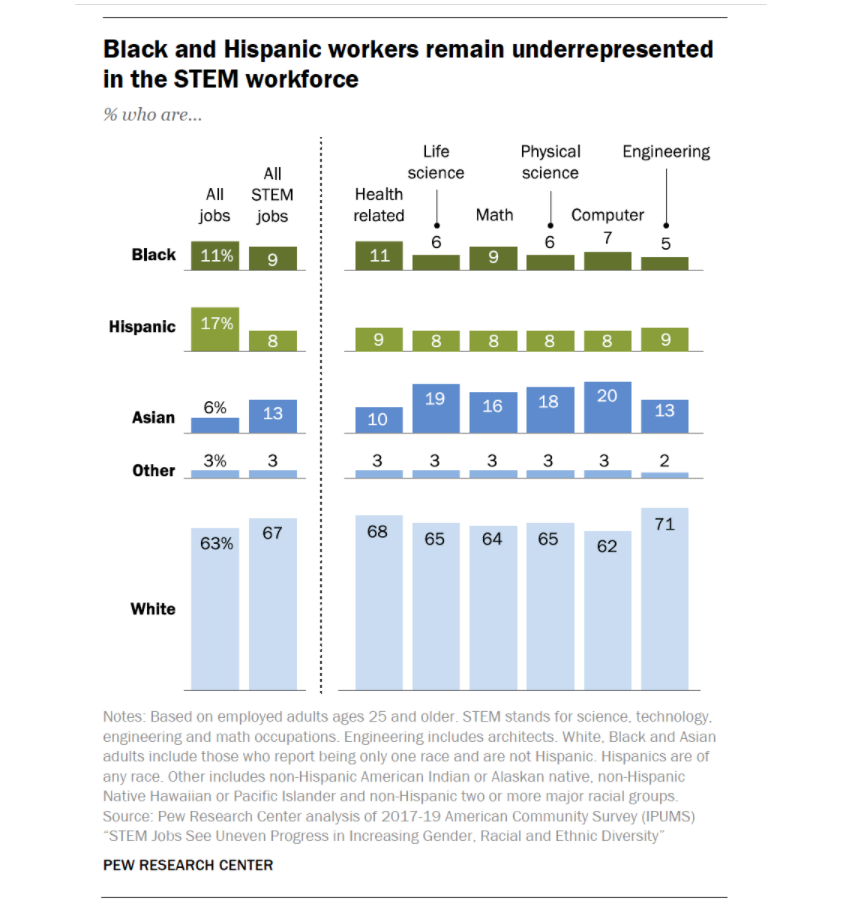Black, Hispanic workers remain underrepresented in STEM: report

The systemic barriers preventing historically excluded individuals from thriving in STEM remain, according to a recent analysis of nearly 20 million people. The survey conducted by Pew Research finds that in 2019, Black people accounted for 9 per cent of the U.S. STEM workforce, a figure that hasn’t increased since 2016. In 2019, about 8 per cent of the STEM workforce was comprised of Hispanic workers, only slightly up from 7 per cent in 2016.
Native American, Native Hawaiian, Pacific Islander, and people who identify with two or more racial groups accounted for 3 per cent of STEM workers, Pew says.
The findings highlight the continued lack of progress in recruiting and retaining Black and Hispanic STEM workers. That’s despite an uptick in enrollments of non-white students in post-secondary science programs, Marcus Lambert, a higher-education researcher at SUNY Downstate Health Sciences University, tells Nature.
“The STEM workforce is connected to the educational pathways,” Lambert said.
“If people are switching majors and dropping out of STEM programmes, we’re not doing our jobs.”
White and Asian workers are overrepresented, accounting for 67 per cent and 13 per cent of all STEM jobs. At first glance, the percentage of Asian STEM workers may not appear high but this demographic represents a 6 per cent share of the total U.S. workforce across all occupations.
The number of Hispanic (8 per cent) and Black (9 per cent) STEM workers is below their overall shares of the total workforce, at 17 per cent and 11 per cent, respectively.

While STEM employees tend to earn more than people in other occupations, the survey finds — surprise, surprise — a compensation discrepancy when analyzing by race, gender, and ethnicity.
The report finds women of all races are making grounds in STEM, earning 53 per cent of STEM college degrees in 2018, although that number is smaller than the 58 per cent of total college degrees earned by women that year. Racial disparities remain, especially among recipients of advanced degrees.
According to the National Center for Education Statistics, of all PhDs awarded to women in 2017/2018 across all disciplines in the U.S. nearly 59 per cent went to white women. Black women made up about 9 per cent of the recipients, Hispanics 8 per cent, and Indigenous women 0.4 per cent.
When we drill down to STEM PhDs the numbers get even smaller. National Center for Science and Engineering Statistics from 2017 suggests that worldwide, only about a third of all doctoral degrees in science, engineering and/or health are held by women.
In 2017, there were entire STEM disciplines that did not award a single doctoral degree to a Black person in the United States — male, female, or non-binary, the Atlantic reports.
Pew makes other gender-based observations, but we’ll take this time to reiterate a point we’ve made many times before: While gender analysis can be insightful, especially when participants are accounted for based on their intersecting identities, an emphasis on male-female genders erases non-binary scientists. We need more research amplifying this group because it is currently so marginalized that it is often difficult to find relevant scientific literature documenting their experiences.
There are countless reasons why historically excluded people leave STEM. One of the big ones has to do with retention, which is mentioned in the Nature article. In 2020, Lambert tells the publication he co-authored a study that surveyed more than 1,200 biomedical postdoctoral researchers in the U.S. about future career plans. It found that 24 per cent of male, non-white postdocs intended to leave research or science, even if they were at advanced stages in their training. This was found to be true for only 14 per cent of white postdocs.
We’ve been covering this topic since We Rep STEM launched in 2019. Here are a few other examples of systemic discrimination at work:

Like what you just read? Support We Rep STEM so we can continue making engaging content.
